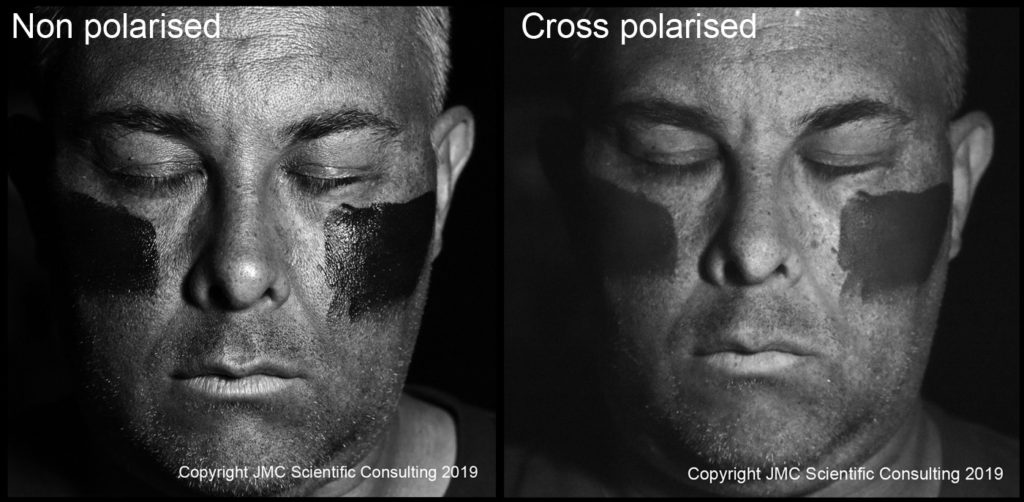My PhD supervisor once told that success was “10% inspiration and 90% perspiration”. At the time I thought that was so deep, and it was only later that I realised that it was a well known quote from Edison. Sums up scientific research well though, so I can forgive the plagiarism. The ideas are great, but making them work, that’s in a different league and it takes effort. A couple of years ago I embarked on a bit of a journey into UV photography to look at sunscreens. This led to me to develop a cross polarised UVA imaging system which is reported here, and resulted in being able visualise both the amount of UV being absorbed by the sunscreen and the finer points of film morphology. The inital work was all done in-vitro, as the technique pushed the capabilities of the imaging equipment available. While I was developing this though, I always had in the back of my mind, “In the end I should be able to do this in-vivo”. At the end of the day, we use sunscreens on ourselves, so I should be able to see them on the skin.
Last year at the ISBS in San Diego, I shared the first images of cross polarised UV photography of sunscreens on skin. It was a small square patch on the back of my hand, and showed the characteristic matt finish from cross polarisation, as the specular shine was removed. It was interesting, but not hugely compelling. Much better to show a face. There are some significant challenges here. A lot of light is needed as the technique robs what light is there. Big powerful lights are by the very nature big, which means a big polariser (and not all polarisers are good for UV, in fact most are terrible). The face is a complex shape, not a flat piece of skin, so the lens needs to be stopped down to improve depth of field. Smaller aperture in the lens, means less light gets to the sensor, so more light is needed at the source. The viscous circle turns back on itself like the diabolical snake eating its tail – complex shaped skin, more powerful and bigger light, bigger polariser, small aperture, more light etc etc.
Over the last couple of years I have been fortunate enough to build up a collection of some pretty special UV imaging equipment. I recently acquired a studio flash, and I thought this might be good for face imaging – to take the simple work on the small square on the back of the hand, shared at the ISBS and scale it up. A bit of work later and I made a holder for a polariser that could be mounted on the flash, and I took the following pair of images – non polarised and cross polarised of my face, with sunscreen on the cheeks.

The non polarised image on the left shows the classical response of a topical film (and indeed the oils on my skin), that of specular reflection which shows up as white highlights. However the cross polarised image loses the highlights, and the skin and sunscreen film now has a matt finish. So what you may ask? If you want to do image analysis to understand how much UV is being absorbed, the presence of specular reflection makes that impossible as the shine hides any absorption. Even a diffuse light source does not get rid of this, as a diffuse light is still a directional light, only cross polarisation can eliminate the shine. Interestingly, the cross polarised images tend to look softer than the non polarised ones. While I am not sure yet, I think this is due the removal of specular reflection. The UV light reaching the camera has not been reflected from the surface of the skin, but has penetrated in, been scattered around, and then come out again. This scattering, or diffuse reflectance, leads to a softening of the image. However that is my working hypothesis and will be refined as I get more data.
This is early days for the method – a single light source and relatively small polariser on the light meant that the illumination isn’t that even across the face, so I need to work on that. I could easily fit a polariser 4 times the size of one I had on my light, and I have 2 lights, which means 8 times the light. This would mean I could drop the ISO and improve the images. Developing an imaging method or measurement technique is rarely straightforward. There are dead-ends and distractions along the way which must be dealt with. Occasionally some manager will come up with the classic line that makes scientists hearts sink, “just do the last experiment first”, as if by some miracle we can just foresee all the problems and work round them. If I could see into the future that well, I’d be funding my research with a lottery win. I’ll stick to the 10% inspiration, 90% perspiration route, thank you. At least that way I learn as I go.
